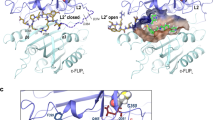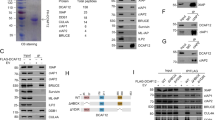Abstract
The death mediator caspase acts as the dominant regulator during cell death induction. The CPP32 subfamily, including caspase 3 (CPP32/Yama/Apopain), is essential for the cell death signaling. We recently reported that activation of caspase 3 is regulated by complex formation with p21 or ILP. In the present study, we investigated the binding domain with p21 and ILP to further characterize the caspase 3 inactivation machinery. Our results show that caspase 3 contains p21 binding domain in the N-terminus and ILP binding domain in the active site. Further, the caspase 3 binding domain in p21 was independent of the Cdk- or PCNA-binding domain. We also found caspase 3 protection by p21 from the p3-site cleavage serineproteinase contributes to the suppression machinery. Here, we propose the caspase 3 inactivation system by p21 and ILP as new essential system in the regulation of cell death.
This is a preview of subscription content, access via your institution
Access options
Subscribe to this journal
Receive 50 print issues and online access
$259.00 per year
only $5.18 per issue
Buy this article
- Purchase on Springer Link
- Instant access to full article PDF
Prices may be subject to local taxes which are calculated during checkout





Similar content being viewed by others
References
Alnemri ES, Livingston DJ, Nicholson DW, Salvesen G, Thornbery NA, Wong WW and Yuan J. . 1996 Cell 87: 171.
Boldin MP, Goncharov TM, Golstev YV and Wallach D. . 1996 Cell 85: 803–815.
Chen J, Jackson PK, Kirschner MW and Dutta A. . 1995 Nature 374: 386–388.
Deveraux QL, Takahashi R, Salvesen GS and Reed JC. . 1997 Nature 388: 300–304.
Fernandes-Alnemri T, Armstrong RC, Krebs J, Srinivasula SM, Wang L, Bullrich F, Fritz LC, Trapani JA, Tomaselli KJ, Litwack G and Alnemri ES. . 1996 Proc. Natl. Acad. Sci. USA 93: 7464–7469.
Fernandes-Alnemri T, Litwack G and Alnemri ES. . 1994 J. Biol. Chem. 267: 30761–30764.
Hasegawa J, Kamada S, Kamiike W, Shimizu S, Imazu T, Matsuda H and Tsujimoto Y. . 1996 Cancer Res. 56: 1713–1718.
Li Y, Jenkins CW, Nichols MA and Xiong Y. . 1994 Oncogene 9: 2261–2268.
Luo Y, Hurwitz J and Massague J. . 1995 Nature 375: 159–161.
Miyazaki K, Umenishi F, Funahashi K, Koshikawa N, Yasumitsu H and Umeda M. . 1992 Biochem. Biophys. Res. Commun. 185: 852–859.
Muzio M, Chinnaiyan AM, Kischkel FC, O'Rourke K, Shevchenko A, Ni J, Scaffidi C, Bretz JD, Zhang M, Gentz R, Mann M, Krammer PH, Peter ME and Dixit VM. . 1996 Cell 85: 817–827.
Nagata S and Golstein P. . 1995 Science 267: 1449–1456.
Nagata S. . 1997 Cell 88: 355–365.
Nakanishi M, Robetorye RS, Adami GR, Pereira-Smith OM and Smith JR. . 1995 EMBO J. 14: 555–563.
Nicholson DW, Ali A, Thornbery NA, Vaillancourt JP, Ding CK, Gallant M, Gareau Y, Griffin PR, Labelle M, Lazebnic YA, Munday NA, Raju SM, Smulson ME, Yamin TT, Yu VL and Miller DK. . 1995 Nature 376: 37–43.
Suzuki A, Iwasaki M, Kato M and Wagai N. . 1997a Exp. Cell. Res. 233: 41–47.
Suzuki A, Iwasaki M and Wagai N. . 1997b Exp. Cell. Res. 233: 48–55.
Suzuki A, Tsutomi Y, Akahane K, Araki T and Miura M. . 1998 Oncogene in press.
Tewari M, Quan LT, O'Rourke K, Desnoyers S, Zeng Z, Beidler DR, Poirier GG, Salvesen GS and Dixit VM. . 1995 Cell 81: 801–809.
Williams MS and Henkart PA. . 1994 J. Immunol. 153: 4247–4255.
Wyllie AH, Kerr JFR and Currie AR. . 1980 Int. Rev. Cytol. 68: 251–306.
Xiong Y, Zhang H and Beach D. . 1993 Genes Dev. 7: 1572–1583.
Yonehara S, Ishii A and Yonehara M. . 1989 J. Exp. Med. 169: 1747–1756.
Acknowledgements
We thank Dr Y Tsujimoto for human hepatoma HepG2 cells, Dr CB Thompson for the ILP cDNA, Dr HR Horvitz for the pET21b-hcpp32-His6 clone plasmid, Dr H Matsushime for pGST-p21 and Dr M Furusawa for his valuable discussion.
Author information
Authors and Affiliations
Rights and permissions
About this article
Cite this article
Suzuki, A., Tsutomi, Y., Miura, M. et al. Caspase 3 inactivation to suppress Fas-mediated apoptosis: identification of binding domain with p21 and ILP and inactivation machinery by p21. Oncogene 18, 1239–1244 (1999). https://doi.org/10.1038/sj.onc.1202409
Received:
Revised:
Accepted:
Published:
Issue Date:
DOI: https://doi.org/10.1038/sj.onc.1202409



